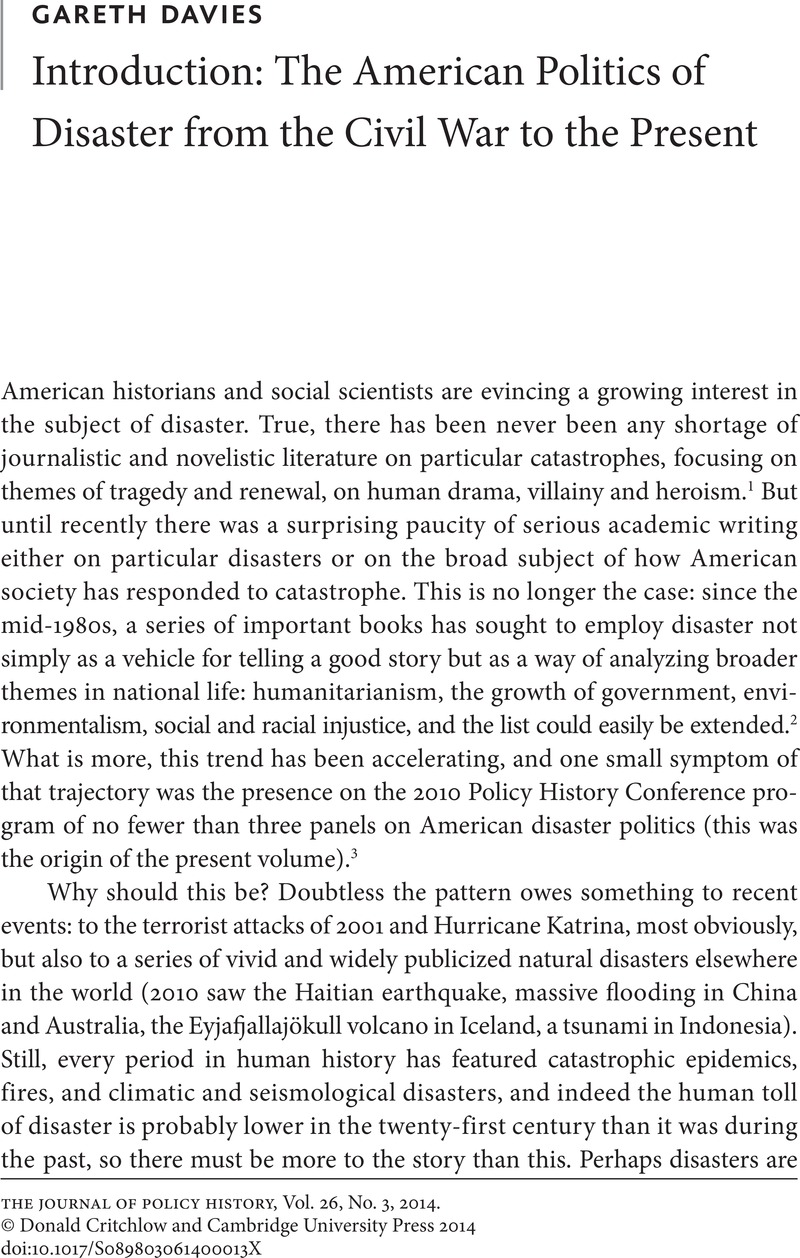No CrossRef data available.
Published online by Cambridge University Press: 09 June 2014

1. For example, see Larson, Erik, Isaac’s Storm: A Man, A Time, and the Deadliest Hurricane in History (New York, 1999)Google Scholar; McCullough, David, The Johnstown Flood (New York, 1968)Google Scholar; Thomas, Gordon and Morgan-Witts, Max, Earthquake: The Destruction of San Francisco (New York, 1971)Google Scholar; Barry, John, Rising Tide: The Great Mississippi Flood of 1927 and How It Changed America (New York, 1997)Google Scholar. See also the popular histories that commonly appeared in the immediate aftermath of the great disasters of the late nineteenth and early twentieth century, such as Lester, Paul, The Great Galveston Disaster—Containing a Full and Thrilling Account of the Most Appalling Calamity of Modern Times Including Vivid Photographs of the Hurricane (Galveston, 1901)Google Scholar, and Dieck, Herman, The Johnstown Flood—A Thriving City of 30,000 Inhabitants and Many Great Industrial Establishments Nearly Wiped from Earth (Philadelphia, 1889).Google Scholar
2. One early landmark was May, Peter, Recovering from Catastrophes: Federal Disaster Relief Policy and Politics (Westport, Conn., 1985)Google Scholar. See also Platt, Rutherford, Disasters and Democracy: The Politics of Extreme Natural Events (Washington, D.C., 1999)Google Scholar; Steinberg, Theodore, Acts of God: The Unnatural History of Natural Disaster in America (New York, 2000)Google Scholar; Rosario, Kevin, The Culture of Calamity: Disaster and the Making of Modern America (Chicago, 2007)CrossRefGoogle Scholar; Lakoff, Andrew, Disaster and the Politics of Intervention (New York, 2010)Google Scholar; Dauber, Michele Landis, The Sympathetic State: Disaster Relief and the Origins of the American Welfare State (Chicago, 2013)Google Scholar; Jones, Marian Moser, The American Red Cross from Clara Barton to the New Deal (Baltimore, 2013)CrossRefGoogle Scholar; Knowles, Scott G., The Disaster Experts: Mastering Risk in Modern America (Philadelphia, 2011)CrossRefGoogle Scholar; Roberts, Patrick, Disasters and the American State: How Politicians, Bureaucrats, and the Public Prepare for the Unexpected (New York, 2013).CrossRefGoogle Scholar
3. Program downloaded from http://jph.asu.edu/conferences (accessed 9 October 2013).
4. The term “CNN Syndrome” was coined in response to the media’s markedly sensational coverage of Hurricane Andrew in 1992. See National Academy of Public Administration, Coping with Catastrophe (Washington, D.C., 1993), xi.Google Scholar
5. See Gareth Davies, “The Changing Presidential Politics of Disaster from Coolidge to Nixon,” in Recasting Presidential History, ed. Brian Balogh and Bruce Schulman (Ithaca, forthcoming).
6. The German reinsurance firm Munich Re has compiled a list of the ten most deadly natural disasters between 1980 and 2012: seven were centered on Asian countries, and two were European heat waves; the only listed disaster to hit the Western hemisphere was the 2010 Haitian earthquake. Even the tenth disaster on the list, the Bam earthquake in southeastern Iran in 2003, resulted in fifteen times as many fatalities as Hurricane Katrina. See “Significant Natural Catastrophes, 1980–2012: Ten Deadliest Worldwide Events,” www.munichre.com (accessed 3 October 2013).
7. See Platt, Disasters and Democracy, plus Knowles and Kunreuther in this volume.
8. On the historiographical consequences of the environmental movement, see McNeill, J. R., “Observations on the Nature and Culture of Environmental History,” History and Theory 42, no. 1 (December 2003): 5–43.CrossRefGoogle Scholar
9. See, for example, Blackbourn, David, The Conquest of Nature: Water, Landscape, and the Making of Modern Germany (London, 2007).Google Scholar
10. U.S. Task Force on Federal Flood Control Policy, A Unified National Problem for Managing Flood Losses (Washington, D.C., 1966), 14.Google Scholar
11. Probably the most ambitious attempt to write a global history of disaster is Parker, Geoffrey, Global Crisis: Climate Change and Catastrophe in the Seventeenth Century (New Haven, 2013)CrossRefGoogle Scholar: going beyond using disaster to illuminate broader patterns, it presents the Little Ice Age as having powerfully shaped them. See also Janku, Andrea, Schenk, Gerrit, and Mauelshagen, Frank, Historical Disaster in Context: Science, Religion, and Politics (New York, 2012)Google Scholar, and Mauelshagen, Franz and Juneja, Monica, “Disasters and Pre-Industrial Societies: Historiographic Trends and Comparative Perspectives,” Medieval History Journal 10, nos. 1–2 (2007): 4–10Google Scholar. For a work of American historiography that takes a transnational approach to disaster, see Tyrrell, Ian, Reforming the World: The Creation of America’s Moral Empire (Princeton, 2010)CrossRefGoogle Scholar. Social scientists are also increasingly taking a transnational approach to understanding disaster: see, for example, Boin, Arjen et al., The Politics of Crisis Management: Public Leadership Under Pressure (Cambridge, 2005).CrossRefGoogle Scholar